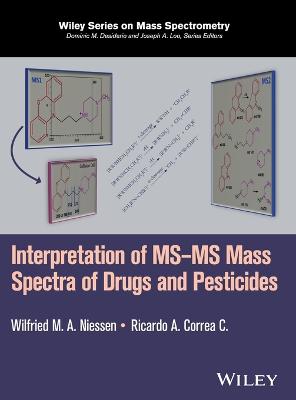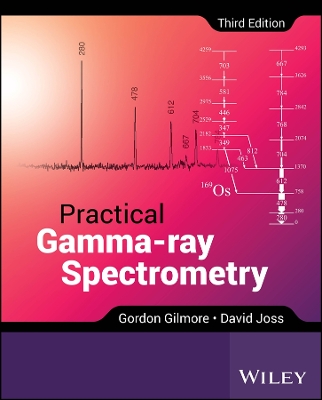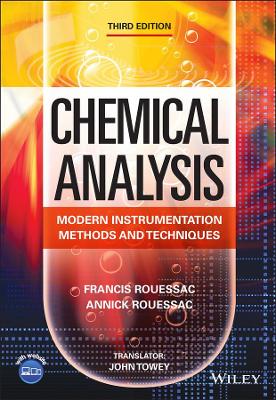Interpretation of MS-MS Mass Spectra of Drugs and Pesticides
 -15%
portes grátis
-15%
portes grátis
Interpretation of MS-MS Mass Spectra of Drugs and Pesticides
Niessen, Wilfried M. A.; Correa C., Ricardo A.
John Wiley & Sons Inc
03/2017
416
Dura
Inglês
9781118500187
15 a 20 dias
1216
Descrição não disponível.
Preface xi
Abbreviations xiii
1 Introduction to LC-MS Technology 1
1.1 Introduction 2
1.2 Analyte Ionization: Ion Sources 3
1.2.1 Electron Ionization 3
1.2.2 Chemical Ionization 7
1.2.3 Atmospheric-Pressure Ionization 13
1.2.4 Electrospray Ionization 16
1.2.5 Atmospheric-Pressure Chemical Ionization and Photoionization 20
1.2.6 Other Ionization Techniques 26
1.3 Mass Spectrometer Building Blocks 28
1.3.1 Introduction 28
1.3.2 Quadrupole Mass Analyzer 32
1.3.3 Ion-Trap Mass Analyzer 33
1.3.4 Time-of-Flight Mass Analyzer 34
1.3.5 Orbitrap Mass Analyzer 35
1.3.6 Other Mass Analyzers 36
1.4 Tandem Mass Spectrometry 37
1.4.1 Introduction 37
1.4.2 Tandem Quadrupole Instruments 39
1.4.3 Ion-Trap Instruments 40
1.4.4 Quadrupole-Linear Ion-Trap Hybrid Instruments 41
1.4.5 Quadrupole-Time-of-Flight Hybrid Instruments 41
1.4.6 Orbitrap Hybrid Instruments for MS-MS and MSn 41
1.4.7 Other Instruments for MS-MS and MSn 42
1.4.8 MS-MS and MSn in the Analysis of Drugs and Pesticides 43
1.5 Data Acquisition 43
1.5.1 Introduction 43
1.5.2 Selected-Ion and Selected-Reaction Monitoring 44
1.5.3 Structure-Specific Screening: Precursor-Ion and Neutral-Loss Analysis 44
1.5.4 Data-Dependent Acquisition 45
1.5.5 Data-Independent Acquisition 45
1.6 Selected Literature on Mass Spectrometry 45
2 Interpretation of Mass Spectra 55
2.1 Mass Spectrometry: A Nuclear Affair 55
2.2 Isomers, Isotones, Isobars, Isotopes 56
2.3 Masses in MS 58
2.4 Isotopes and Structure Elucidation 60
2.5 Nitrogen Rule, Ring Double-Bond Equivalent, and Hydrogen Rule 61
2.6 Resolving Power, Resolution, Accuracy 63
2.7 Calculating Elemental Composition from Accurate m/z 66
2.8 Protonated and Deprotonated Molecules and Adduct Ions 67
3 Fragmentation of Even-Electron Ions 71
3.1 Introduction 72
3.2 Analyte Ionization Revisited 73
3.3 Fragmentation of Odd-electron Ions 74
3.4 High-energy Collisions of Protonated Molecules 76
3.4.1 General Aspects 77
3.4.2 Selected Examples 79
3.5 Fragmentation of Protonated Molecules 81
3.5.1 Singly-Charged Peptides 82
3.5.2 Protonated Small Molecules: Complementary Fragment Ions 83
3.5.3 Fragmentation of Peptides Revisited 86
3.5.4 Direct-Cleavage Reactions 89
3.5.5 Consecutive Small-Molecule Losses 89
3.5.6 Other Fragmentation Reactions 89
3.5.7 Loss of Radicals from Even-Electron Ions 91
3.5.8 Skeletal Rearrangements in Protonated Molecules 92
3.6 Characteristic Positive-ion Fragmentation of Functional Groups 94
3.6.1 Cleavages of C-C Bonds 94
3.6.2 Alcohols and Ethers 95
3.6.3 Aldehydes and Ketones 96
3.6.4 Carboxylic Acids and Esters 96
3.6.5 Amines and Quaternary Ammonium Compounds 98
3.6.6 Amides, Sulfonyl Ureas, and Carbamates 99
3.6.7 Compounds containing Phosphorus or Sulfur 101
3.6.8 Miscellaneous Compound Classes 101
3.7 Fragmentation of Deprotonated Molecules 102
3.7.1 High-Energy CID with NICI-Generated Deprotonated Molecules 102
3.7.2 General Aspects 102
3.7.3 Alcohols and Ethers 102
3.7.4 Carboxylic Acid and Esters 103
3.7.5 Amines 104
3.7.6 Amides and Ureas 104
3.7.7 Sulfonamides and Related Sulfones 106
3.7.8 Halogenated Compounds 107
3.7.9 Miscellaneous Compound Classes 108
3.8 Fragmentation of Metal-ion Cationized Molecules 108
3.9 Generation of Odd-electron Ions in ESI-MS, APCI-MS, and APPI-MS 111
3.10 Useful Tables 112
4 Fragmentation of Drugs and Pesticides 129
4.1 Fragmentation of Drugs for Cardiovascular Diseases and Hypertension 134
4.1.1 ?-Blockers or ?-Adrenergic Antagonists 134
4.1.2 Dihydropyridine Calcium Antagonists 137
4.1.3 Angiotensin-Converting Enzyme Inhibitors 140
4.1.4 Diuretic Drugs 142
4.1.5 Angiotensin II Receptor Antagonists 148
4.1.6 Other Antihypertensive Compounds 149
4.1.7 Antiarrhythmic Agents 153
4.2 Fragmentation of Psychotropic or Psychoactive Drugs 158
4.2.1 Phenothiazines 158
4.2.2 Other Classes of Neuroleptic Drugs 161
4.2.3 Antidepressants 163
4.2.4 Benzodiazepines 167
4.2.5 Local Anesthetics 173
4.2.6 Barbiturates 173
4.2.7 Anticonvulsant Drugs 174
4.2.8 Other Psychotropic Drugs 175
4.3 Fragmentation of Analgesic, Antipyretic, and Anti-Inflammatory Drugs 179
4.3.1 Acetaminophen 179
4.3.2 Salicylic Acid Derivatives 179
4.3.3 Nonsteroidal Anti-Inflammatory Drugs 180
4.3.4 COX-2 Inhibitors 184
4.4 Fragmentation of Drugs Related to Digestion and the Gastrointestinal Tract 188
4.4.1 Antidiabetic Drugs 188
4.4.2 Antiulcer Drugs 191
4.4.3 Lipid-Lowering Agents 192
4.4.4 Anorexic Drugs 195
4.4.5 Antiemetic Drugs 196
4.5 Fragmentation of Other Classes of Drugs 199
4.5.1 ?-Adrenergic Receptor Agonists 199
4.5.2 Histamine Antagonists 199
4.5.3 Anticholinergic Agents 202
4.5.4 Drugs against Alzheimer's Disease: Acetylcholinesterase Inhibitors 204
4.5.5 Antiparkinsonian Drugs 208
4.5.6 Antineoplastic and Cytostatic Drugs 209
4.5.7 Immunosuppressive Drugs 214
4.5.8 X-ray Contrast Agents 216
4.5.9 Anticoagulants and Rodenticides 218
4.5.10 Conclusions 219
4.6 Fragmentation of Steroids 222
4.6.1 Introduction 222
4.6.2 Fragmentation of Steroids 223
4.6.3 Fragmentation in 3-Keto-?4-Steroids 224
4.6.4 Anabolic Steroids 225
4.6.5 Progestogens 227
4.6.6 Corticosteroids 228
4.6.7 Estrogens 234
4.6.8 Steroid Conjugates 236
4.7 Fragmentation of Drugs of Abuse 241
4.7.1 Introduction 241
4.7.2 Amphetamine and Related Compounds 241
4.7.3 Cannabinoids 248
4.7.4 Cocaine and Related Substances 250
4.7.5 Opiates 251
4.7.6 Miscellaneous Drugs of Abuse 252
4.7.7 Designer Drugs 255
4.8 Fragmentation of Antimicrobial Compounds 262
4.8.1 Sulfonamides 262
4.8.2 Chloramphenicol and Related Compounds 265
4.8.3 ?-Lactams 266
4.8.4 (Fluoro)quinolones 273
4.8.5 Aminoglycosides 277
4.8.6 Tetracyclines 279
4.8.7 Nitrofurans 279
4.8.8 Macrolides 281
4.8.9 Miscellaneous Antibiotics 282
4.9 Fragmentation of Antimycotic and Antifungal Compounds 289
4.9.1 Imidazolyl Antimycotic Compounds 289
4.9.2 Triazolyl Antifungal Compounds 290
4.9.3 Benzamidazole Fungicides 292
4.9.4 Other Classes of Fungicides 293
4.10 Fragmentation of Other Antibiotic Compounds 297
4.10.1 Anthelmintic Drugs 297
4.10.2 Antiprotozoal, Coccidiostatic, and Antimalarial Agents 299
4.10.3 Antiviral Drugs 304
4.10.4 Antiseptics and Disinfectants 309
4.11 Pesticides 315
4.11.1 Triazine Herbicides 315
4.11.2 Carbamates 317
4.11.3 Quaternary Ammonium Herbicides 322
4.11.4 Organophosphorus Pesticides 322
4.11.5 Urea Herbicides: Phenylureas, Benzoylphenylureas, and Others 329
4.11.6 Sulfonylurea Herbicides 334
4.11.7 Chlorinated Phenoxy Acid Herbicides 337
4.11.8 Phenolic Compounds 339
4.11.9 Miscellaneous Herbicides 339
5 Identification Strategies 351
5.1 Introduction 351
5.2 Confirmation of Identity in Following Organic Synthesis 352
5.3 Confirmation of Identity in Targeted Screening by SRM-based Strategies 353
5.3.1 Environmental Analysis 354
5.3.2 Food Safety Analysis 355
5.3.3 Sports Doping Analysis 355
5.3.4 General Unknown Screening in Toxicology 355
5.4 Confirmation of Identity by High-resolution Accurate-mass MS Strategies 356
5.4.1 Environmental and Food Safety Analysis 356
5.4.2 General Unknown Screening in Toxicology 357
5.4.3 Sports Doping Analysis 357
5.5 Library Searching Strategies in Systematic Toxicological Analysis 357
5.6 Dereplication and Identification of Natural Products and Endogenous Compounds 360
5.7 Identification of Structure-related Substances 361
5.7.1 Drug Metabolites 362
5.7.2 Impurities and Degradation Products 366
5.8 Identification of Known Unknowns and Real Unknowns 366
Compound Index 381
Subject Index
Abbreviations xiii
1 Introduction to LC-MS Technology 1
1.1 Introduction 2
1.2 Analyte Ionization: Ion Sources 3
1.2.1 Electron Ionization 3
1.2.2 Chemical Ionization 7
1.2.3 Atmospheric-Pressure Ionization 13
1.2.4 Electrospray Ionization 16
1.2.5 Atmospheric-Pressure Chemical Ionization and Photoionization 20
1.2.6 Other Ionization Techniques 26
1.3 Mass Spectrometer Building Blocks 28
1.3.1 Introduction 28
1.3.2 Quadrupole Mass Analyzer 32
1.3.3 Ion-Trap Mass Analyzer 33
1.3.4 Time-of-Flight Mass Analyzer 34
1.3.5 Orbitrap Mass Analyzer 35
1.3.6 Other Mass Analyzers 36
1.4 Tandem Mass Spectrometry 37
1.4.1 Introduction 37
1.4.2 Tandem Quadrupole Instruments 39
1.4.3 Ion-Trap Instruments 40
1.4.4 Quadrupole-Linear Ion-Trap Hybrid Instruments 41
1.4.5 Quadrupole-Time-of-Flight Hybrid Instruments 41
1.4.6 Orbitrap Hybrid Instruments for MS-MS and MSn 41
1.4.7 Other Instruments for MS-MS and MSn 42
1.4.8 MS-MS and MSn in the Analysis of Drugs and Pesticides 43
1.5 Data Acquisition 43
1.5.1 Introduction 43
1.5.2 Selected-Ion and Selected-Reaction Monitoring 44
1.5.3 Structure-Specific Screening: Precursor-Ion and Neutral-Loss Analysis 44
1.5.4 Data-Dependent Acquisition 45
1.5.5 Data-Independent Acquisition 45
1.6 Selected Literature on Mass Spectrometry 45
2 Interpretation of Mass Spectra 55
2.1 Mass Spectrometry: A Nuclear Affair 55
2.2 Isomers, Isotones, Isobars, Isotopes 56
2.3 Masses in MS 58
2.4 Isotopes and Structure Elucidation 60
2.5 Nitrogen Rule, Ring Double-Bond Equivalent, and Hydrogen Rule 61
2.6 Resolving Power, Resolution, Accuracy 63
2.7 Calculating Elemental Composition from Accurate m/z 66
2.8 Protonated and Deprotonated Molecules and Adduct Ions 67
3 Fragmentation of Even-Electron Ions 71
3.1 Introduction 72
3.2 Analyte Ionization Revisited 73
3.3 Fragmentation of Odd-electron Ions 74
3.4 High-energy Collisions of Protonated Molecules 76
3.4.1 General Aspects 77
3.4.2 Selected Examples 79
3.5 Fragmentation of Protonated Molecules 81
3.5.1 Singly-Charged Peptides 82
3.5.2 Protonated Small Molecules: Complementary Fragment Ions 83
3.5.3 Fragmentation of Peptides Revisited 86
3.5.4 Direct-Cleavage Reactions 89
3.5.5 Consecutive Small-Molecule Losses 89
3.5.6 Other Fragmentation Reactions 89
3.5.7 Loss of Radicals from Even-Electron Ions 91
3.5.8 Skeletal Rearrangements in Protonated Molecules 92
3.6 Characteristic Positive-ion Fragmentation of Functional Groups 94
3.6.1 Cleavages of C-C Bonds 94
3.6.2 Alcohols and Ethers 95
3.6.3 Aldehydes and Ketones 96
3.6.4 Carboxylic Acids and Esters 96
3.6.5 Amines and Quaternary Ammonium Compounds 98
3.6.6 Amides, Sulfonyl Ureas, and Carbamates 99
3.6.7 Compounds containing Phosphorus or Sulfur 101
3.6.8 Miscellaneous Compound Classes 101
3.7 Fragmentation of Deprotonated Molecules 102
3.7.1 High-Energy CID with NICI-Generated Deprotonated Molecules 102
3.7.2 General Aspects 102
3.7.3 Alcohols and Ethers 102
3.7.4 Carboxylic Acid and Esters 103
3.7.5 Amines 104
3.7.6 Amides and Ureas 104
3.7.7 Sulfonamides and Related Sulfones 106
3.7.8 Halogenated Compounds 107
3.7.9 Miscellaneous Compound Classes 108
3.8 Fragmentation of Metal-ion Cationized Molecules 108
3.9 Generation of Odd-electron Ions in ESI-MS, APCI-MS, and APPI-MS 111
3.10 Useful Tables 112
4 Fragmentation of Drugs and Pesticides 129
4.1 Fragmentation of Drugs for Cardiovascular Diseases and Hypertension 134
4.1.1 ?-Blockers or ?-Adrenergic Antagonists 134
4.1.2 Dihydropyridine Calcium Antagonists 137
4.1.3 Angiotensin-Converting Enzyme Inhibitors 140
4.1.4 Diuretic Drugs 142
4.1.5 Angiotensin II Receptor Antagonists 148
4.1.6 Other Antihypertensive Compounds 149
4.1.7 Antiarrhythmic Agents 153
4.2 Fragmentation of Psychotropic or Psychoactive Drugs 158
4.2.1 Phenothiazines 158
4.2.2 Other Classes of Neuroleptic Drugs 161
4.2.3 Antidepressants 163
4.2.4 Benzodiazepines 167
4.2.5 Local Anesthetics 173
4.2.6 Barbiturates 173
4.2.7 Anticonvulsant Drugs 174
4.2.8 Other Psychotropic Drugs 175
4.3 Fragmentation of Analgesic, Antipyretic, and Anti-Inflammatory Drugs 179
4.3.1 Acetaminophen 179
4.3.2 Salicylic Acid Derivatives 179
4.3.3 Nonsteroidal Anti-Inflammatory Drugs 180
4.3.4 COX-2 Inhibitors 184
4.4 Fragmentation of Drugs Related to Digestion and the Gastrointestinal Tract 188
4.4.1 Antidiabetic Drugs 188
4.4.2 Antiulcer Drugs 191
4.4.3 Lipid-Lowering Agents 192
4.4.4 Anorexic Drugs 195
4.4.5 Antiemetic Drugs 196
4.5 Fragmentation of Other Classes of Drugs 199
4.5.1 ?-Adrenergic Receptor Agonists 199
4.5.2 Histamine Antagonists 199
4.5.3 Anticholinergic Agents 202
4.5.4 Drugs against Alzheimer's Disease: Acetylcholinesterase Inhibitors 204
4.5.5 Antiparkinsonian Drugs 208
4.5.6 Antineoplastic and Cytostatic Drugs 209
4.5.7 Immunosuppressive Drugs 214
4.5.8 X-ray Contrast Agents 216
4.5.9 Anticoagulants and Rodenticides 218
4.5.10 Conclusions 219
4.6 Fragmentation of Steroids 222
4.6.1 Introduction 222
4.6.2 Fragmentation of Steroids 223
4.6.3 Fragmentation in 3-Keto-?4-Steroids 224
4.6.4 Anabolic Steroids 225
4.6.5 Progestogens 227
4.6.6 Corticosteroids 228
4.6.7 Estrogens 234
4.6.8 Steroid Conjugates 236
4.7 Fragmentation of Drugs of Abuse 241
4.7.1 Introduction 241
4.7.2 Amphetamine and Related Compounds 241
4.7.3 Cannabinoids 248
4.7.4 Cocaine and Related Substances 250
4.7.5 Opiates 251
4.7.6 Miscellaneous Drugs of Abuse 252
4.7.7 Designer Drugs 255
4.8 Fragmentation of Antimicrobial Compounds 262
4.8.1 Sulfonamides 262
4.8.2 Chloramphenicol and Related Compounds 265
4.8.3 ?-Lactams 266
4.8.4 (Fluoro)quinolones 273
4.8.5 Aminoglycosides 277
4.8.6 Tetracyclines 279
4.8.7 Nitrofurans 279
4.8.8 Macrolides 281
4.8.9 Miscellaneous Antibiotics 282
4.9 Fragmentation of Antimycotic and Antifungal Compounds 289
4.9.1 Imidazolyl Antimycotic Compounds 289
4.9.2 Triazolyl Antifungal Compounds 290
4.9.3 Benzamidazole Fungicides 292
4.9.4 Other Classes of Fungicides 293
4.10 Fragmentation of Other Antibiotic Compounds 297
4.10.1 Anthelmintic Drugs 297
4.10.2 Antiprotozoal, Coccidiostatic, and Antimalarial Agents 299
4.10.3 Antiviral Drugs 304
4.10.4 Antiseptics and Disinfectants 309
4.11 Pesticides 315
4.11.1 Triazine Herbicides 315
4.11.2 Carbamates 317
4.11.3 Quaternary Ammonium Herbicides 322
4.11.4 Organophosphorus Pesticides 322
4.11.5 Urea Herbicides: Phenylureas, Benzoylphenylureas, and Others 329
4.11.6 Sulfonylurea Herbicides 334
4.11.7 Chlorinated Phenoxy Acid Herbicides 337
4.11.8 Phenolic Compounds 339
4.11.9 Miscellaneous Herbicides 339
5 Identification Strategies 351
5.1 Introduction 351
5.2 Confirmation of Identity in Following Organic Synthesis 352
5.3 Confirmation of Identity in Targeted Screening by SRM-based Strategies 353
5.3.1 Environmental Analysis 354
5.3.2 Food Safety Analysis 355
5.3.3 Sports Doping Analysis 355
5.3.4 General Unknown Screening in Toxicology 355
5.4 Confirmation of Identity by High-resolution Accurate-mass MS Strategies 356
5.4.1 Environmental and Food Safety Analysis 356
5.4.2 General Unknown Screening in Toxicology 357
5.4.3 Sports Doping Analysis 357
5.5 Library Searching Strategies in Systematic Toxicological Analysis 357
5.6 Dereplication and Identification of Natural Products and Endogenous Compounds 360
5.7 Identification of Structure-related Substances 361
5.7.1 Drug Metabolites 362
5.7.2 Impurities and Degradation Products 366
5.8 Identification of Known Unknowns and Real Unknowns 366
Compound Index 381
Subject Index
Este título pertence ao(s) assunto(s) indicados(s). Para ver outros títulos clique no assunto desejado.
LC-MS; MS-MS; Tandem mass spectrometry; Electrospray ionization; Atmospheric pressure chemical ionization; Electron ionisation; Positive ion chemical ionization; Negative ion chemical ionization; Fragmentation; Collision-induced dissociation; Even-electron ions; Protonated molecules; Deprotonated molecules; Cardiovascular drugs; Anti-inflammatory drugs; Antibiotics; Anti-diabetic drugs; Anthelmintic drugs; Antimicrobial drugs; Antimycotic drugs; Antineoplastic drugs; Antiviral drugs; Cytostatic drugs; Gastrointestinal drugs; Immunosuppressive drugs; Steroids; Psychotropic drugs; Psychoactive drugs; Drugs of abuse; Designer drugs; Pesticides; Herbicides
Preface xi
Abbreviations xiii
1 Introduction to LC-MS Technology 1
1.1 Introduction 2
1.2 Analyte Ionization: Ion Sources 3
1.2.1 Electron Ionization 3
1.2.2 Chemical Ionization 7
1.2.3 Atmospheric-Pressure Ionization 13
1.2.4 Electrospray Ionization 16
1.2.5 Atmospheric-Pressure Chemical Ionization and Photoionization 20
1.2.6 Other Ionization Techniques 26
1.3 Mass Spectrometer Building Blocks 28
1.3.1 Introduction 28
1.3.2 Quadrupole Mass Analyzer 32
1.3.3 Ion-Trap Mass Analyzer 33
1.3.4 Time-of-Flight Mass Analyzer 34
1.3.5 Orbitrap Mass Analyzer 35
1.3.6 Other Mass Analyzers 36
1.4 Tandem Mass Spectrometry 37
1.4.1 Introduction 37
1.4.2 Tandem Quadrupole Instruments 39
1.4.3 Ion-Trap Instruments 40
1.4.4 Quadrupole-Linear Ion-Trap Hybrid Instruments 41
1.4.5 Quadrupole-Time-of-Flight Hybrid Instruments 41
1.4.6 Orbitrap Hybrid Instruments for MS-MS and MSn 41
1.4.7 Other Instruments for MS-MS and MSn 42
1.4.8 MS-MS and MSn in the Analysis of Drugs and Pesticides 43
1.5 Data Acquisition 43
1.5.1 Introduction 43
1.5.2 Selected-Ion and Selected-Reaction Monitoring 44
1.5.3 Structure-Specific Screening: Precursor-Ion and Neutral-Loss Analysis 44
1.5.4 Data-Dependent Acquisition 45
1.5.5 Data-Independent Acquisition 45
1.6 Selected Literature on Mass Spectrometry 45
2 Interpretation of Mass Spectra 55
2.1 Mass Spectrometry: A Nuclear Affair 55
2.2 Isomers, Isotones, Isobars, Isotopes 56
2.3 Masses in MS 58
2.4 Isotopes and Structure Elucidation 60
2.5 Nitrogen Rule, Ring Double-Bond Equivalent, and Hydrogen Rule 61
2.6 Resolving Power, Resolution, Accuracy 63
2.7 Calculating Elemental Composition from Accurate m/z 66
2.8 Protonated and Deprotonated Molecules and Adduct Ions 67
3 Fragmentation of Even-Electron Ions 71
3.1 Introduction 72
3.2 Analyte Ionization Revisited 73
3.3 Fragmentation of Odd-electron Ions 74
3.4 High-energy Collisions of Protonated Molecules 76
3.4.1 General Aspects 77
3.4.2 Selected Examples 79
3.5 Fragmentation of Protonated Molecules 81
3.5.1 Singly-Charged Peptides 82
3.5.2 Protonated Small Molecules: Complementary Fragment Ions 83
3.5.3 Fragmentation of Peptides Revisited 86
3.5.4 Direct-Cleavage Reactions 89
3.5.5 Consecutive Small-Molecule Losses 89
3.5.6 Other Fragmentation Reactions 89
3.5.7 Loss of Radicals from Even-Electron Ions 91
3.5.8 Skeletal Rearrangements in Protonated Molecules 92
3.6 Characteristic Positive-ion Fragmentation of Functional Groups 94
3.6.1 Cleavages of C-C Bonds 94
3.6.2 Alcohols and Ethers 95
3.6.3 Aldehydes and Ketones 96
3.6.4 Carboxylic Acids and Esters 96
3.6.5 Amines and Quaternary Ammonium Compounds 98
3.6.6 Amides, Sulfonyl Ureas, and Carbamates 99
3.6.7 Compounds containing Phosphorus or Sulfur 101
3.6.8 Miscellaneous Compound Classes 101
3.7 Fragmentation of Deprotonated Molecules 102
3.7.1 High-Energy CID with NICI-Generated Deprotonated Molecules 102
3.7.2 General Aspects 102
3.7.3 Alcohols and Ethers 102
3.7.4 Carboxylic Acid and Esters 103
3.7.5 Amines 104
3.7.6 Amides and Ureas 104
3.7.7 Sulfonamides and Related Sulfones 106
3.7.8 Halogenated Compounds 107
3.7.9 Miscellaneous Compound Classes 108
3.8 Fragmentation of Metal-ion Cationized Molecules 108
3.9 Generation of Odd-electron Ions in ESI-MS, APCI-MS, and APPI-MS 111
3.10 Useful Tables 112
4 Fragmentation of Drugs and Pesticides 129
4.1 Fragmentation of Drugs for Cardiovascular Diseases and Hypertension 134
4.1.1 ?-Blockers or ?-Adrenergic Antagonists 134
4.1.2 Dihydropyridine Calcium Antagonists 137
4.1.3 Angiotensin-Converting Enzyme Inhibitors 140
4.1.4 Diuretic Drugs 142
4.1.5 Angiotensin II Receptor Antagonists 148
4.1.6 Other Antihypertensive Compounds 149
4.1.7 Antiarrhythmic Agents 153
4.2 Fragmentation of Psychotropic or Psychoactive Drugs 158
4.2.1 Phenothiazines 158
4.2.2 Other Classes of Neuroleptic Drugs 161
4.2.3 Antidepressants 163
4.2.4 Benzodiazepines 167
4.2.5 Local Anesthetics 173
4.2.6 Barbiturates 173
4.2.7 Anticonvulsant Drugs 174
4.2.8 Other Psychotropic Drugs 175
4.3 Fragmentation of Analgesic, Antipyretic, and Anti-Inflammatory Drugs 179
4.3.1 Acetaminophen 179
4.3.2 Salicylic Acid Derivatives 179
4.3.3 Nonsteroidal Anti-Inflammatory Drugs 180
4.3.4 COX-2 Inhibitors 184
4.4 Fragmentation of Drugs Related to Digestion and the Gastrointestinal Tract 188
4.4.1 Antidiabetic Drugs 188
4.4.2 Antiulcer Drugs 191
4.4.3 Lipid-Lowering Agents 192
4.4.4 Anorexic Drugs 195
4.4.5 Antiemetic Drugs 196
4.5 Fragmentation of Other Classes of Drugs 199
4.5.1 ?-Adrenergic Receptor Agonists 199
4.5.2 Histamine Antagonists 199
4.5.3 Anticholinergic Agents 202
4.5.4 Drugs against Alzheimer's Disease: Acetylcholinesterase Inhibitors 204
4.5.5 Antiparkinsonian Drugs 208
4.5.6 Antineoplastic and Cytostatic Drugs 209
4.5.7 Immunosuppressive Drugs 214
4.5.8 X-ray Contrast Agents 216
4.5.9 Anticoagulants and Rodenticides 218
4.5.10 Conclusions 219
4.6 Fragmentation of Steroids 222
4.6.1 Introduction 222
4.6.2 Fragmentation of Steroids 223
4.6.3 Fragmentation in 3-Keto-?4-Steroids 224
4.6.4 Anabolic Steroids 225
4.6.5 Progestogens 227
4.6.6 Corticosteroids 228
4.6.7 Estrogens 234
4.6.8 Steroid Conjugates 236
4.7 Fragmentation of Drugs of Abuse 241
4.7.1 Introduction 241
4.7.2 Amphetamine and Related Compounds 241
4.7.3 Cannabinoids 248
4.7.4 Cocaine and Related Substances 250
4.7.5 Opiates 251
4.7.6 Miscellaneous Drugs of Abuse 252
4.7.7 Designer Drugs 255
4.8 Fragmentation of Antimicrobial Compounds 262
4.8.1 Sulfonamides 262
4.8.2 Chloramphenicol and Related Compounds 265
4.8.3 ?-Lactams 266
4.8.4 (Fluoro)quinolones 273
4.8.5 Aminoglycosides 277
4.8.6 Tetracyclines 279
4.8.7 Nitrofurans 279
4.8.8 Macrolides 281
4.8.9 Miscellaneous Antibiotics 282
4.9 Fragmentation of Antimycotic and Antifungal Compounds 289
4.9.1 Imidazolyl Antimycotic Compounds 289
4.9.2 Triazolyl Antifungal Compounds 290
4.9.3 Benzamidazole Fungicides 292
4.9.4 Other Classes of Fungicides 293
4.10 Fragmentation of Other Antibiotic Compounds 297
4.10.1 Anthelmintic Drugs 297
4.10.2 Antiprotozoal, Coccidiostatic, and Antimalarial Agents 299
4.10.3 Antiviral Drugs 304
4.10.4 Antiseptics and Disinfectants 309
4.11 Pesticides 315
4.11.1 Triazine Herbicides 315
4.11.2 Carbamates 317
4.11.3 Quaternary Ammonium Herbicides 322
4.11.4 Organophosphorus Pesticides 322
4.11.5 Urea Herbicides: Phenylureas, Benzoylphenylureas, and Others 329
4.11.6 Sulfonylurea Herbicides 334
4.11.7 Chlorinated Phenoxy Acid Herbicides 337
4.11.8 Phenolic Compounds 339
4.11.9 Miscellaneous Herbicides 339
5 Identification Strategies 351
5.1 Introduction 351
5.2 Confirmation of Identity in Following Organic Synthesis 352
5.3 Confirmation of Identity in Targeted Screening by SRM-based Strategies 353
5.3.1 Environmental Analysis 354
5.3.2 Food Safety Analysis 355
5.3.3 Sports Doping Analysis 355
5.3.4 General Unknown Screening in Toxicology 355
5.4 Confirmation of Identity by High-resolution Accurate-mass MS Strategies 356
5.4.1 Environmental and Food Safety Analysis 356
5.4.2 General Unknown Screening in Toxicology 357
5.4.3 Sports Doping Analysis 357
5.5 Library Searching Strategies in Systematic Toxicological Analysis 357
5.6 Dereplication and Identification of Natural Products and Endogenous Compounds 360
5.7 Identification of Structure-related Substances 361
5.7.1 Drug Metabolites 362
5.7.2 Impurities and Degradation Products 366
5.8 Identification of Known Unknowns and Real Unknowns 366
Compound Index 381
Subject Index
Abbreviations xiii
1 Introduction to LC-MS Technology 1
1.1 Introduction 2
1.2 Analyte Ionization: Ion Sources 3
1.2.1 Electron Ionization 3
1.2.2 Chemical Ionization 7
1.2.3 Atmospheric-Pressure Ionization 13
1.2.4 Electrospray Ionization 16
1.2.5 Atmospheric-Pressure Chemical Ionization and Photoionization 20
1.2.6 Other Ionization Techniques 26
1.3 Mass Spectrometer Building Blocks 28
1.3.1 Introduction 28
1.3.2 Quadrupole Mass Analyzer 32
1.3.3 Ion-Trap Mass Analyzer 33
1.3.4 Time-of-Flight Mass Analyzer 34
1.3.5 Orbitrap Mass Analyzer 35
1.3.6 Other Mass Analyzers 36
1.4 Tandem Mass Spectrometry 37
1.4.1 Introduction 37
1.4.2 Tandem Quadrupole Instruments 39
1.4.3 Ion-Trap Instruments 40
1.4.4 Quadrupole-Linear Ion-Trap Hybrid Instruments 41
1.4.5 Quadrupole-Time-of-Flight Hybrid Instruments 41
1.4.6 Orbitrap Hybrid Instruments for MS-MS and MSn 41
1.4.7 Other Instruments for MS-MS and MSn 42
1.4.8 MS-MS and MSn in the Analysis of Drugs and Pesticides 43
1.5 Data Acquisition 43
1.5.1 Introduction 43
1.5.2 Selected-Ion and Selected-Reaction Monitoring 44
1.5.3 Structure-Specific Screening: Precursor-Ion and Neutral-Loss Analysis 44
1.5.4 Data-Dependent Acquisition 45
1.5.5 Data-Independent Acquisition 45
1.6 Selected Literature on Mass Spectrometry 45
2 Interpretation of Mass Spectra 55
2.1 Mass Spectrometry: A Nuclear Affair 55
2.2 Isomers, Isotones, Isobars, Isotopes 56
2.3 Masses in MS 58
2.4 Isotopes and Structure Elucidation 60
2.5 Nitrogen Rule, Ring Double-Bond Equivalent, and Hydrogen Rule 61
2.6 Resolving Power, Resolution, Accuracy 63
2.7 Calculating Elemental Composition from Accurate m/z 66
2.8 Protonated and Deprotonated Molecules and Adduct Ions 67
3 Fragmentation of Even-Electron Ions 71
3.1 Introduction 72
3.2 Analyte Ionization Revisited 73
3.3 Fragmentation of Odd-electron Ions 74
3.4 High-energy Collisions of Protonated Molecules 76
3.4.1 General Aspects 77
3.4.2 Selected Examples 79
3.5 Fragmentation of Protonated Molecules 81
3.5.1 Singly-Charged Peptides 82
3.5.2 Protonated Small Molecules: Complementary Fragment Ions 83
3.5.3 Fragmentation of Peptides Revisited 86
3.5.4 Direct-Cleavage Reactions 89
3.5.5 Consecutive Small-Molecule Losses 89
3.5.6 Other Fragmentation Reactions 89
3.5.7 Loss of Radicals from Even-Electron Ions 91
3.5.8 Skeletal Rearrangements in Protonated Molecules 92
3.6 Characteristic Positive-ion Fragmentation of Functional Groups 94
3.6.1 Cleavages of C-C Bonds 94
3.6.2 Alcohols and Ethers 95
3.6.3 Aldehydes and Ketones 96
3.6.4 Carboxylic Acids and Esters 96
3.6.5 Amines and Quaternary Ammonium Compounds 98
3.6.6 Amides, Sulfonyl Ureas, and Carbamates 99
3.6.7 Compounds containing Phosphorus or Sulfur 101
3.6.8 Miscellaneous Compound Classes 101
3.7 Fragmentation of Deprotonated Molecules 102
3.7.1 High-Energy CID with NICI-Generated Deprotonated Molecules 102
3.7.2 General Aspects 102
3.7.3 Alcohols and Ethers 102
3.7.4 Carboxylic Acid and Esters 103
3.7.5 Amines 104
3.7.6 Amides and Ureas 104
3.7.7 Sulfonamides and Related Sulfones 106
3.7.8 Halogenated Compounds 107
3.7.9 Miscellaneous Compound Classes 108
3.8 Fragmentation of Metal-ion Cationized Molecules 108
3.9 Generation of Odd-electron Ions in ESI-MS, APCI-MS, and APPI-MS 111
3.10 Useful Tables 112
4 Fragmentation of Drugs and Pesticides 129
4.1 Fragmentation of Drugs for Cardiovascular Diseases and Hypertension 134
4.1.1 ?-Blockers or ?-Adrenergic Antagonists 134
4.1.2 Dihydropyridine Calcium Antagonists 137
4.1.3 Angiotensin-Converting Enzyme Inhibitors 140
4.1.4 Diuretic Drugs 142
4.1.5 Angiotensin II Receptor Antagonists 148
4.1.6 Other Antihypertensive Compounds 149
4.1.7 Antiarrhythmic Agents 153
4.2 Fragmentation of Psychotropic or Psychoactive Drugs 158
4.2.1 Phenothiazines 158
4.2.2 Other Classes of Neuroleptic Drugs 161
4.2.3 Antidepressants 163
4.2.4 Benzodiazepines 167
4.2.5 Local Anesthetics 173
4.2.6 Barbiturates 173
4.2.7 Anticonvulsant Drugs 174
4.2.8 Other Psychotropic Drugs 175
4.3 Fragmentation of Analgesic, Antipyretic, and Anti-Inflammatory Drugs 179
4.3.1 Acetaminophen 179
4.3.2 Salicylic Acid Derivatives 179
4.3.3 Nonsteroidal Anti-Inflammatory Drugs 180
4.3.4 COX-2 Inhibitors 184
4.4 Fragmentation of Drugs Related to Digestion and the Gastrointestinal Tract 188
4.4.1 Antidiabetic Drugs 188
4.4.2 Antiulcer Drugs 191
4.4.3 Lipid-Lowering Agents 192
4.4.4 Anorexic Drugs 195
4.4.5 Antiemetic Drugs 196
4.5 Fragmentation of Other Classes of Drugs 199
4.5.1 ?-Adrenergic Receptor Agonists 199
4.5.2 Histamine Antagonists 199
4.5.3 Anticholinergic Agents 202
4.5.4 Drugs against Alzheimer's Disease: Acetylcholinesterase Inhibitors 204
4.5.5 Antiparkinsonian Drugs 208
4.5.6 Antineoplastic and Cytostatic Drugs 209
4.5.7 Immunosuppressive Drugs 214
4.5.8 X-ray Contrast Agents 216
4.5.9 Anticoagulants and Rodenticides 218
4.5.10 Conclusions 219
4.6 Fragmentation of Steroids 222
4.6.1 Introduction 222
4.6.2 Fragmentation of Steroids 223
4.6.3 Fragmentation in 3-Keto-?4-Steroids 224
4.6.4 Anabolic Steroids 225
4.6.5 Progestogens 227
4.6.6 Corticosteroids 228
4.6.7 Estrogens 234
4.6.8 Steroid Conjugates 236
4.7 Fragmentation of Drugs of Abuse 241
4.7.1 Introduction 241
4.7.2 Amphetamine and Related Compounds 241
4.7.3 Cannabinoids 248
4.7.4 Cocaine and Related Substances 250
4.7.5 Opiates 251
4.7.6 Miscellaneous Drugs of Abuse 252
4.7.7 Designer Drugs 255
4.8 Fragmentation of Antimicrobial Compounds 262
4.8.1 Sulfonamides 262
4.8.2 Chloramphenicol and Related Compounds 265
4.8.3 ?-Lactams 266
4.8.4 (Fluoro)quinolones 273
4.8.5 Aminoglycosides 277
4.8.6 Tetracyclines 279
4.8.7 Nitrofurans 279
4.8.8 Macrolides 281
4.8.9 Miscellaneous Antibiotics 282
4.9 Fragmentation of Antimycotic and Antifungal Compounds 289
4.9.1 Imidazolyl Antimycotic Compounds 289
4.9.2 Triazolyl Antifungal Compounds 290
4.9.3 Benzamidazole Fungicides 292
4.9.4 Other Classes of Fungicides 293
4.10 Fragmentation of Other Antibiotic Compounds 297
4.10.1 Anthelmintic Drugs 297
4.10.2 Antiprotozoal, Coccidiostatic, and Antimalarial Agents 299
4.10.3 Antiviral Drugs 304
4.10.4 Antiseptics and Disinfectants 309
4.11 Pesticides 315
4.11.1 Triazine Herbicides 315
4.11.2 Carbamates 317
4.11.3 Quaternary Ammonium Herbicides 322
4.11.4 Organophosphorus Pesticides 322
4.11.5 Urea Herbicides: Phenylureas, Benzoylphenylureas, and Others 329
4.11.6 Sulfonylurea Herbicides 334
4.11.7 Chlorinated Phenoxy Acid Herbicides 337
4.11.8 Phenolic Compounds 339
4.11.9 Miscellaneous Herbicides 339
5 Identification Strategies 351
5.1 Introduction 351
5.2 Confirmation of Identity in Following Organic Synthesis 352
5.3 Confirmation of Identity in Targeted Screening by SRM-based Strategies 353
5.3.1 Environmental Analysis 354
5.3.2 Food Safety Analysis 355
5.3.3 Sports Doping Analysis 355
5.3.4 General Unknown Screening in Toxicology 355
5.4 Confirmation of Identity by High-resolution Accurate-mass MS Strategies 356
5.4.1 Environmental and Food Safety Analysis 356
5.4.2 General Unknown Screening in Toxicology 357
5.4.3 Sports Doping Analysis 357
5.5 Library Searching Strategies in Systematic Toxicological Analysis 357
5.6 Dereplication and Identification of Natural Products and Endogenous Compounds 360
5.7 Identification of Structure-related Substances 361
5.7.1 Drug Metabolites 362
5.7.2 Impurities and Degradation Products 366
5.8 Identification of Known Unknowns and Real Unknowns 366
Compound Index 381
Subject Index
Este título pertence ao(s) assunto(s) indicados(s). Para ver outros títulos clique no assunto desejado.
LC-MS; MS-MS; Tandem mass spectrometry; Electrospray ionization; Atmospheric pressure chemical ionization; Electron ionisation; Positive ion chemical ionization; Negative ion chemical ionization; Fragmentation; Collision-induced dissociation; Even-electron ions; Protonated molecules; Deprotonated molecules; Cardiovascular drugs; Anti-inflammatory drugs; Antibiotics; Anti-diabetic drugs; Anthelmintic drugs; Antimicrobial drugs; Antimycotic drugs; Antineoplastic drugs; Antiviral drugs; Cytostatic drugs; Gastrointestinal drugs; Immunosuppressive drugs; Steroids; Psychotropic drugs; Psychoactive drugs; Drugs of abuse; Designer drugs; Pesticides; Herbicides







